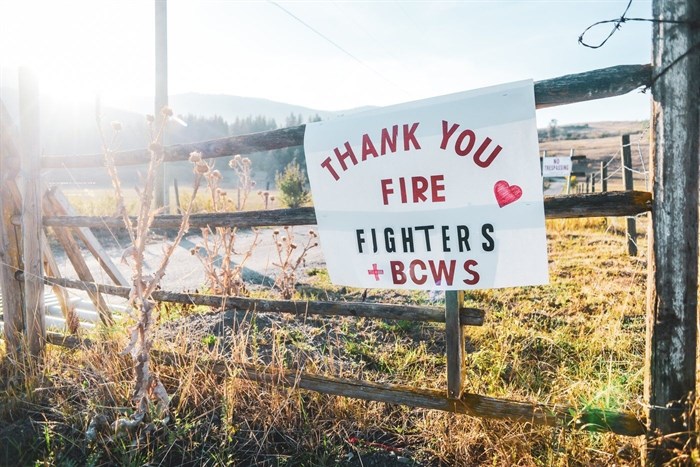
“Thank you firefighters and BCWS (BC Wildfire Services),” reads a sign outside the Irish Creek area of the Okanagan Indian Band community.
Image Credit: Kelsie Kilawna, Local Journalism Initiative
September 16, 2021 - 6:00 PM
As the Okanagan Indian Band recovers from the White Rock Lake wildfire, Chief Byron Louis is asking the public to respect the backcountry and the wildlife, and to avoid entering the community — which lies on syilx territory in B.C.’s southern interior — unless it’s to access a local business.
On social media, OKIB community members have reported seeing people from outside the community pulling over to watch them and take photos while they look through charred remains and clear away debris.
“We got right on that,” Louis said in a phone interview. “We had RCMP and private security telling people it’s not something you do. What was going on out here was not for entertainment.”
He’s asking the public to be mindful and to refrain from entering the community to get to the backcountry, as the fire’s still burning.
More than 800 square kilometres of gathering grounds and wildlife habitat have been burned in the local mountains, says Louis.
“You’re going into forests that are very unstable. The roots are still burning, and even with slight effects like wind blowing [it] can knock these trees down. It’s so unsafe.”
Louis says keeping the backcountry closed is essential for the wildlife population.
“Animals are stressed out enough,” especially in the “lower elevations where deer and that are starting to settle,” Louis says.
“Keep in mind with deer coming lower, so are the predators — cougars, and others.”
Taking care of animal kin
In addition to cleaning up and repairing or replacing homes and businesses, the community’s addressing the displacement of wildlife, a major food source.
“What’s going to happen when the whole mountain top has been burned off — well, that forces animals down slope. Now we’re seeing bears in the community,” he says.
“Just recently we’re watching this one black bear, and you could see this poor thing was so hungry, and they were after all the chokecherries.”
Louis and others in the community are actively taking care of animal kin that have been displaced, their habitats gravely damaged by the fire.
“We took what was in our freezer — the berries, the salmon, and all our meats — and we took it up the hill and dropped it off for the animals,” Louis says.
“Because what’s going to happen to these [animals] when they are going into hibernation underweight? Well, then they are going to be waking up early, at a time where there will be absolutely nothing.”
Louis says he’s particularly concerned about the impact of habitat loss on recovering species in the area, such as the elk population.
“Elk that are just starting to recover on this side,” he continues, “When you have all their winter range burnt off to a large degree, well, they are going to be migrating out of a large area where they are recovering.”
He’s asking hunters to be mindful.
“We’ve been asking people not to hunt lower in the valley or on the reserve because those animals are highly stressed,” he says. “They’ll be lower in the valley all winter long and we can’t stress them more by hunting them.”
— This story was originally published by The Discourse and IndigiNews.
News from © iNFOnews, 2021